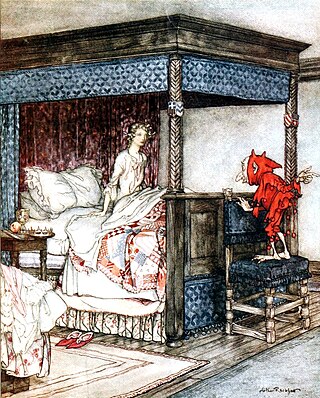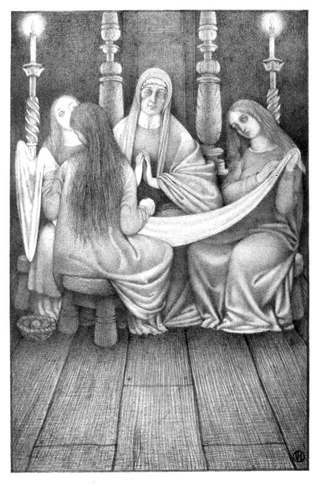"The Queen of Elfan's Nourice" or "The Queen of Elfland's Nourice" is Child ballad number 40, [1] although fragmentary in form. [2]
"The Queen of Elfan's Nourice" or "The Queen of Elfland's Nourice" is Child ballad number 40, [1] although fragmentary in form. [2]
A mortal woman laments being taken from her four-day-old son. The Queen of Elfland promises that if she nurses the queen's child, she will be returned. The Queen then points out their path: the road to Elfland, rather than to Heaven or Hell. [3]
The path to Elfland appears to be taken from the ballad "Thomas the Rhymer" rather than be a part of this tale. [4]
The plot of the ballad revolves about a common piece of folklore, the taking of human woman to Elfland to nurse fairy babies; [5] women were often regarded as being in particular danger of being taken by the fairies immediately after giving birth. [6]
This ballad was one of 25 traditional works included in Ballads Weird and Wonderful (1912) and illustrated by Vernon Hill. [7]

Sir Thomas de Ercildoun, better remembered as Thomas the Rhymer, also known as Thomas Learmont or True Thomas, was a Scottish laird and reputed prophet from Earlston in the Borders. Thomas' gift of prophecy is linked to his poetic ability.

TamLin is a character in a legendary ballad originating from the Scottish Borders. It is also associated with a reel of the same name, also known as the Glasgow Reel. The story revolves around the rescue of Tam Lin by his true love from the Queen of the Fairies. The motif of winning a person by holding him through all forms of transformation is found throughout Europe in folktales.

A changeling, also historically referred to as an auf or oaf, is a human-like creature found in folklore throughout Europe. A changeling was believed to be a fairy that had been left in place of a human stolen by other fairies.
Sir Aldingar is Child ballad 59. Francis James Child collected three variants, two fragmentary, in The English and Scottish Popular Ballads. All three recount the tale where a rebuffed Sir Aldingar slanders his mistress, Queen Eleanor, and a miraculous champion saves her.
"The Elfin Knight" is a traditional Scottish folk ballad of which there are many versions, all dealing with supernatural occurrences, and the commission to perform impossible tasks. The ballad has been collected in different parts of England, Scotland, Ireland, the US, and Canada. As is the case with most traditional folk songs, there have been countless completely different versions recorded of the same ballad. The first broadside version was printed before 1674, and the roots of the song may be considerably older.
"Allison Gross" is a traditional ballad, catalogued as Child Ballad #35. It tells the story of "the ugliest witch in the north country" who tries to persuade a man to become her lover and then punishes him by a transformation.

Billy Blind is an English and Lowland Scottish household spirit, much like a brownie. He appears only in ballads, where he frequently advises the characters. It is possible that the character of Billy Blind is a folk memory of the god Woden or Odin from Germanic mythology, in his "more playful aspect" and is speculated to have been the same character as Blind Harie, the "blind man of the game" in Scotland.
Willie's Lady is Child ballad number 6 and Roud #220. The earliest known copy of the ballad is from a recitation transcribed in 1783.
"The Laily Worm and the Machrel of the Sea" is Child ballad number 36.

"Hind Horn" is a traditional English and Scottish folk ballad.
"Hind Etin" is a folk ballad existing in several variants.

"Lord Thomas and Fair Annet", also known as "Lord Thomas and Fair Eleanor", is an English folk ballad.
"Young Waters" is Child ballad number 94.
Leesome Brand is Child Ballad number 15 and Roud #3301.
Fause Foodrage is a Scottish murder ballad of the 17th or 18th century. It was first printed by Walter Scott in Minstrelsy of the Scottish Border (1802). Scott cited Elizabeth, Lady Wardlaw as the ballad's probable author.
"Gil Brenton" is Child ballad 5, Roud 22, existing in several variants.
"Earl Brand" is a pseudo-historical English ballad.
Sweet William's Ghost is an English Ballad and folk song which exists in many lyrical variations and musical arrangements. Early known printings of the song include Allan Ramsay's The Tea-Table Miscellany in 1740 and Thomas Percy's Reliques of Ancient English Poetry in 1765. Percy believed that the last two stanzas of the version he published were later additions, but that the details of the story they recounted were original.
"Brown Robyn's Confession" is Child ballad 57.
Queen of Elphame or "Elf-hame", in the folklore belief of Lowland Scotland and Northern England, designates the elfin queen of Faerie, mentioned in Scottish witch trials. In ballads and contemporary texts, she is referred to as Queen of Elphane, Elphen, or the Fairies. She is equivalent to the Queen of Fairy who rules Faërie or Fairyland. The character as described in witch trials has many parallels with the legends of Thomas the Rhymer and Tam Lin.